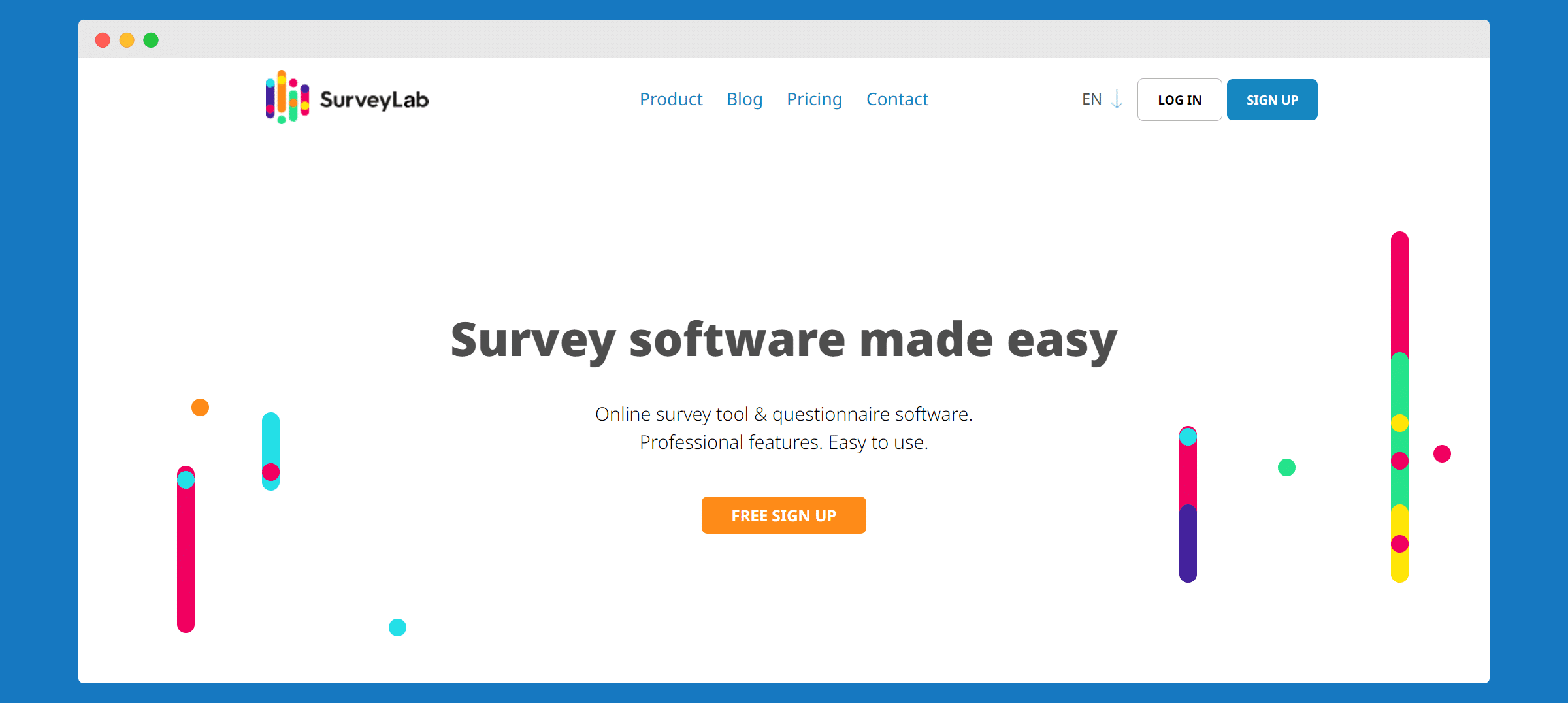Whether you’re measuring customer satisfaction or exploring complex attitudes, Likert scales offer a clear, quantitative insight into your target audience’s minds.
Let’s explore the potential of this versatile tool together.
What is Likert scale?
A Likert scale is a psychometric scale commonly used in survey research to measure attitudes or opinions with a range of answer options from “strongly agree” to “strongly disagree.”

Where to use Likert scale?
No limits here. You can use whenever you find it useful. However, we’ve gathered the most common cases.
Understanding customer satisfaction
Likert scale examples are pivotal in measuring customer satisfaction.
Businesses can pinpoint exactly how consumers feel about a particular product or service using a 5-point Likert scale. It provides a nuanced view of customer sentiment, from “very satisfied” to “very dissatisfied.”
✔️ Benefit: It enables companies to tailor their offerings and improve customer experiences.
Evaluating employee engagement
Likert scale questions help HR departments assess employee engagement and satisfaction. They ask employees to rate their agreement with statements about their workplace.
✔️ Benefit: Companies can identify areas of strength and opportunities for improvement, fostering a positive work environment.
Market research insights
When presenting respondents with a series of Likert scale questions, researchers can collect quantitative data that reflects consumer preferences and expectations.
✔️ Benefit: Guiding product development and marketing strategies.
Assessing educational outcomes
Educational institutions often use Likert scale questionnaires to evaluate teaching effectiveness and student satisfaction.
Educators can measure the impact of their teaching methods and curriculum.
✔️ Benefit: They can meet students’ needs better and foster an enriching learning environment.
Healthcare patient feedback
In healthcare, this method is essential for understanding patient experiences and outcomes. Hospitals and clinics can measure patient satisfaction with care, identify areas for improvement.
✔️ Benefit: Enhanced quality of healthcare services by using a rating scale.
Social science research
Social scientists rely on Likert scales to explore attitudes, beliefs, and behaviors. In social phenomena, researchers can uncover patterns and correlations based on responses to even Likert scale questions.
✔️ Benefit: More valuable insights to the field.
Product feedback and development
Companies use Likert scale examples to gather feedback on products. It lets businesses assess customer reactions to specific features or overall satisfaction with a product.
✔️ Benefit: Contributing to future development and innovation strategies.
Service Improvement
Service-oriented businesses benefit from Likert scale surveys as they can gauge the quality of their service. Through targeted survey questions, companies can understand the factors driving customer satisfaction or dissatisfaction.
✔️ Benefit: Strategic improvements.

Likert scale examples
Now, let’s take a look at detailed examples to get a better understanding of the Likert scale.
#1 Crafting effective Likert scale questions
Creating impactful Likert scale questions is an art that involves clarity, relevance, and balance.
A well-designed Likert scale survey question can capture the intensity of respondents’ feelings towards a particular statement and give them insights beyond simple yes/no answers.
A 5-point Likert scale ranging from “strongly agree” to “strongly disagree” provides a nuanced view of opinions.
➡️ Examples: How strongly do you agree or disagree with the following statement: ‘This product meets my expectations.’
Please rate your agreement with the following statement: ‘The customer service was helpful and responsive.
Ensure questions are unbiased and cover a spectrum of possible responses. It allows for accurate measurement of attitudes or satisfaction levels.
It’s very useful in customer satisfaction surveys, where understanding subtle differences in perception can guide improvements in products or services.
#2 Utilizing Likert scales in customer satisfaction
When employing a point Likert scale, businesses can quantify satisfaction levels, ranging from “very satisfied” to “very dissatisfied.” It offers a clear, actionable data set that highlights areas of success and opportunities for improvement.
➡️ Examples: On a scale from ‘very satisfied’ to ‘very dissatisfied,’ how would you rate your overall satisfaction with our service?
How much do you agree with this statement: ‘I am satisfied with the quality of the product received.’
#3 Enhancing data quality with Likert scales
The quality of survey data is paramount, and Likert scales contribute significantly to improving this aspect.
Provide a range of answer options, from “strongly agree” to “strongly disagree,” for a more detailed analysis of responses.
You will understand the intensity of respondents’ feelings towards a given statement, leading to more nuanced insights.
Also, including a neutral option like “neither agree nor disagree” ensures that respondents who do not have a strong opinion on the matter can still participate.
➡️ Examples: Please indicate your level of agreement with the statement: ‘The instructions were clear and easy to follow.
Rate your agreement with: ‘I feel that my feedback is valued by this organization.’
#4 Designing Likert scale surveys for online platforms
Online surveys have become a staple in market research, and Likert scales adapt well to this format.
When designing Likert scale surveys for online distribution, it’s crucial to consider the user experience.
Clear and concise questions, along with a simple-to-understand rating scale, encourage participation and honest answers. Online platforms also offer the flexibility to include various types of Likert scale questions, from 5-point scales for straightforward opinions to more detailed 7-point scales for complex issues, allowing researchers to collect a wide range of data.
➡️ Examples: How strongly do you agree or disagree with the statement: ‘Navigating the online survey was easy and intuitive.’
To what extent do you agree with the following: ‘The survey questions were relevant to my experience.’
If you’re looking for a tool to help you with online surveys, SurveyLab is a great tool. It’s easy to use — creating your Likert scale questionnaire (and not only) may be a breeze!
Sign up and craft your survey today!

#5 Analyzing responses from Likert scale surveys
It involves aggregating the responses to each Likert scale question and analyzing them to identify trends, patterns, and areas of consensus or divergence among respondents.
If a significant number of respondents “strongly agree” with a positive statement about a product, it indicates high satisfaction. Conversely, a trend of “strongly disagree” responses might highlight areas needing improvement.
This analysis helps organizations to make informed decisions based on the collective opinions of their target audience.
➡️ Examples: Please rate your agreement with: ‘The product’s features meet my needs.’
How much do you agree with this statement: ‘The company values customer feedback.’
#6 Applying Likert scales in educational research
In educational settings, Likert scales offer a method to assess attitudes, perceptions, and behaviors of students and educators.
For instance, a Likert scale questionnaire might explore students’ level of agreement with statements regarding the effectiveness of a new teaching method.
Educators can measure the impact of instructional innovations and identify areas for enhancement. Similarly, Likert scales can measure educators’ perspectives on professional development programs.
➡️ Examples: Rate your level of agreement with the statement: ‘The new teaching method has improved my learning experience.’
How strongly do you agree or disagree with: ‘The course material is engaging and stimulating.’
#7 Leveraging Likert scales for employee feedback
Likert scale surveys facilitate engagement and performance asking employees to rate their agreement with statements related to job satisfaction, workplace environment, and organizational culture.
It’s a structured way for employees to express their opinions, which can be invaluable in identifying strengths and addressing areas of concern within the organization.
Regularly conducting such surveys helps maintain a pulse on employee sentiment and fosters a culture of continuous improvement.
➡️ Examples: Please indicate your agreement with the following: ‘I am satisfied with my work-life balance.’
“Rate your level of agreement with: ‘The organizational culture supports employee development.’
#8 Incorporating Likert scales in healthcare patient feedback
It’s extensively used in patient satisfaction surveys. Patients are asked to rate their experiences with various aspects of care, from the clarity of communication to the level of empathy shown by healthcare providers.
The feedback is crucial for healthcare organizations hoping to enhance patient care and satisfaction. Healthcare providers can address patient needs effectively through systematically analyzing responses.
➡️ Examples: On a scale from ‘strongly agree’ to ‘strongly disagree,’ how would you rate your agreement with: ‘The healthcare staff communicated clearly and effectively.’
Please rate your satisfaction with the level of empathy shown by our healthcare providers during your visit.
Key takeaways
- Likert scales are essential tools for measuring attitudes and opinions across various fields. You can create such surveys with Surveylab.
- They offer nuanced insights by providing a range of response options from “strongly agree” to “strongly disagree.”
- Effective Likert scale questions are clear, unbiased, and balanced to ensure accurate data collection.
- They are versatile and can be used in customer satisfaction, employee feedback, market research, and more.
- Analyzing Likert scale responses helps identify trends and areas for improvement.
- Online surveys benefit from the adaptability and user-friendly nature of Likert scales.
- Including a neutral option enhances data quality by accommodating all respondent views.
- 5-point and 7-point scales are common, but the choice depends on the level of detail required.
- Regular use of Likert scales can guide strategic decisions and improvements.
- They bridge the gap between quantitative data and qualitative insights, making them invaluable for research.
Conclusion
From enhancing customer satisfaction to refining educational methods, Likert scales provide a structured approach to gathering valuable insights.
With the right questions, survey tool, and careful analysis, you can unlock actionable data to drive decisions and improvements. Sign in to SurveyLab, and collect feedback with ease.
Now it’s your turn to implement these insights and see the difference they can make to measure customer satisfaction.
Good luck!
FAQ on Likert survey questions
Got questions? We may have the answers.
What is a Likert scale example?
A Likert scale example is a question in a survey that asks respondents to rate their level of agreement with a statement. It includes options like “strongly agree,” “agree,” “neutral,” “disagree,” and “strongly disagree.”
What is the 5-point Likert scale?
The 5-point Likert scale is a popular format that provides respondents with five response options to express their level of agreement or disagreement with a statement, typically ranging from “strongly agree” to “strongly disagree.”
What is the most popular Likert scale?
The most popular Likert scale is the 5-point scale, valued for its simplicity and effectiveness in capturing a wide range of opinions without overwhelming respondents with too many options.
What are the 7 items on the Likert scale?
The 7 items on a Likert scale typically include three positive response options (e.g., “strongly agree,” “agree,” “somewhat agree”), a neutral option (“neither agree nor disagree”), and three negative response options (e.g., “somewhat disagree,” “disagree,” “strongly disagree”), allowing for more nuanced feedback.
